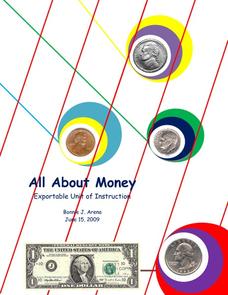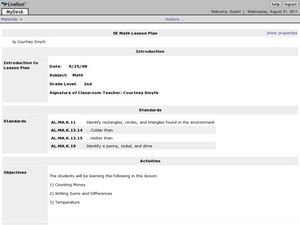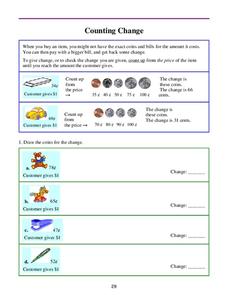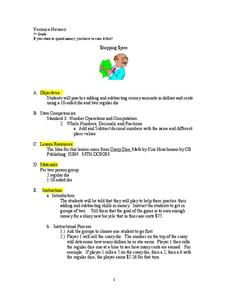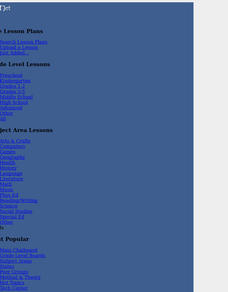Curated OER
All About Money
Few topics engage young mathematicians as much as learning about money. Through a series of shared readings and hands-on activities, children explore the US currency system, learning how to count money and calculate change as they create...
Curated OER
Who Has More Money?
Coloring and money combine in this fun instructional activity! First and second graders count the amounts of money represented in each, and then color the person or animal who has the most money. They then draw the correct coins to add...
Curated OER
Choosing Coins
In this mathematics worksheet, 1st graders identify what coins can be used to buy a toy train. Then they count out how much money is given and write that amount in cents. Students also trace or draw the coins to match each price listed.
Curated OER
Counting Money Activity
Second graders explore commerce by practicing monetary transactions. In this consumer math lesson, 2nd graders practice using math functions to add and subtract different amounts of money. Students identify the different monetary units...
K12 Reader
Money, Money, Everywhere!
Pennies, nickels, dimes, quarters, half-dollars, dollars. Here's a comprehension worksheet that asks young readers to respond to a series of questions based on a passage about money.
US Department of Agriculture
Agriculture Counts
Agricultural survey and the documentation of livestock or goods was the basis for the first written language. Youngsters discuss sorting and counting, and how these skills have been used for thousands of years. They accent their class...
Curated OER
Managing My Money
Second graders use The Berenstain Bears' to learn about money management. In this money management lesson, 2nd graders read The Berenstain Bears' Dollars and Sense book and complete the 'Rainy Day' worksheet. Students then discuss the...
Curated OER
Adding and Subtracting Money
Students investigate U.S. currency by pretending to buy food. In this money lesson plan, students discover the vocabulary and value for each U.S. coin, then add the amounts in dollars and cents of food items they wish to purchase....
Curated OER
It's On Sale
First graders read the book The Great Pet Sale to learn about economics and advertisements. In this economics lesson plan, 1st graders read the book The Great Pet Sale and define related vocabulary words. Students compare prices to find...
Curated OER
Saving Makes Cents
Students identify ways families save money. In this financial instructional activity, students read the book A Chair for My Mother and discuss ways to save money. Students identify coin values and practice counting money.
Curated OER
Counting Change
In this counting change worksheet, pupils practice calculating the change after purchasing an item four times. Students draw the coins for the change.
Curated OER
Money and Business (Art)
Third graders investigate world currency by creating their own coin art. For this government lesson, 3rd graders examine the characteristics of different coins and create their own design for a new one. Students discuss and...
Curated OER
How Much is that Name?
Students explore money counting. In this money problem solving lesson, students calculate how much money their name is "worth" using the corresponding alphabet letters which have been assigned a coin value.
Alabama Learning Exchange
Pat Brisson's Benny's Pennies
Learners listen to the book, "Benny's Pennies" and conduct math and language arts lessons to go along with the book. They demonstrate their ability to count pennies, understand proper sequence, and rewrite a story using different...
Curated OER
Money Matters
Students practice spending money by completing math word sentences. In this economics lesson, students utilize problem solving strategies to complete word problems written on the board involving making purchases with money....
Curated OER
Practice Shopping
In this money worksheet, students draw the specific coins that make up 9 different amounts of money. Students add together 4 sets of coins and cross out the coins needed to purchase 9 various items found in a grocery store.
Curated OER
Agriculture Counts
Students discuss the kinds of things they count and how to use tally marks. In this social science lesson, students count animal crackers by using tally marks for each kind of animal. The tally marks are changed into numbers and one...
Curated OER
Tzedakah: How Can We Help?
Young scholars define what constitutes a nutritious meal, the price of a healthy meal, and understand that some people can't afford healthy meals. In this healthy meals lesson plan, students estimate and research the cost of a nutritious...
Curated OER
How Much for Your Name?
Students create different coin combinations for a single amount, practice counting, demonstrate their knowledge of the value of coins and demonstrate their knowledge of coin combinations.
Curated OER
Shopping Spree
Sixth graders examine currency by completing monetary equations. In this economics lesson, 6th graders participate in a numbers experiment where they roll a die and earn money based on their roll. Students compete for their...
Curated OER
For Sale!
Students review same type (denomination) coin sets, and build same type coin sets equaling fifty cents.
Curated OER
Pocket Change
Students explore algebraic relationships using the coins in their "pocket." Interactive games that demonstrate the use of estimation in algebraic problem solving help them build a framework for understanding word problems in a way that...
Curated OER
Spelling Payment (Elementary, Mathematics)
Students practice spelling words and earn points (Each spelling word is assigned a value.) for each one spelled correctly. They keep track of money earned and may purchase items at the end of the month.
Curated OER
I Want It All!
Third graders understand the economics of choices in buying. For this goods and services lesson, 3rd graders participate in activities to make choices about purchases. Students write stories, answer questions, and complete worksheets to...
